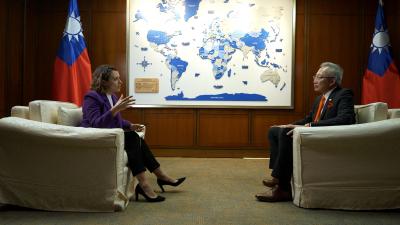When the Taiwan Broadcasting System (TBS, 公廣集團) was established two years ago, its mission was to provide the nation with a truly independent, non-profit public television service free from state interference.
However, the problems and conflicts of the past two years have led some to question whether the consolidation of five television stations has succeeded in creating one large independent public medium.
TBS consists of the Chinese Television Station (CTS), the Public Television Station (PTS), Hakka TV, Taiwan Indigenous Television (TiTV) and Taiwan Macroview Television, with each having different historical backgrounds and sources of funding.
PTS is supervised by the Public Television Service Foundation, whose operation is partially funded by the government while CTS was previously owned by the military. Although the Statue Regarding the Disposition of Government Shareholdings in the Terrestrial Television Industry (無線電視事業公股處理條例) dictated that political parties, the government and military withdraw from media operations, it also required one of the previously state-run TV stations to remain a public asset.
While Taiwan Television (TTV) went private, CTS became a member station of TBS.
Hakka TV and TiTV are funded by the Council of Hakka Affairs and the Indigenous Peoples Commission respectively. Each provides about NT$400 million (US$13 million) to subsidize their station. Their funding is partially appropriated by the PTS Foundation to offer program production support to both stations.
Macroview Television is in charge of TV broadcasts to overseas Taiwanese and is funded by the Overseas Compatriot Affairs Commission.
From the beginning, PTS and CTS management constantly argued over the style of news they should present, with the former criticizing the latter for having too much advertising in news broadcasts.
CTS, on other hand, has always been a commercial television station, but it is now commissioned to function as a public service. As such, CTS has had to forgo some sources of commercial revenue, such as running campaign ads for political parties.
While PBS receives annual funding of NT$900 million from the Government Information Office, CTS receives no subsidies.
Its status as a public medium also restricts the types of program CTS can produce. Shrinking ratings and advertising worsened its situation and the station had accumulated losses of NT$1 billion even before it became a public service broadcaster.
Neither Hakka TV or TiTV have benefited much from the consolidation. Both continued to outsource a majority of their production to private contractors or other TV stations. The PTS Foundation merely placed some of their production crews under the management of both stations.
Lawmakers are not satisfied with the operation of TBS. In a legislative meeting last month, Chinese Nationalist Party (KMT) Legislator Hung Hsiu-chu (洪秀柱) described TBS as a “bottomless money pit.”
She suggested selling CTS to an interested private investor as TBS simply cannot afford to bear CTS’ financial losses year after year.
Wei Ti (魏玓), an assistant professor of communications and technology at National Chiao Tung University, disagreed.
He said investment in the public television system was small compared with other countries.
Wei said on average, the annual amount invested in public television is NT$389 per person in South Korea and NT$3,376 in Britain. In Taiwan, the amount is just NT$39 per person, he said.
Chen Shi-tsung (陳信聰), a former research fellow in the PTS’ strategy research and development department, said there would not be a public TV system big enough to compete with commercial television if CTS was spun off from TBS.
Chen said the Government Information Office should be the only government agency budgeting operational funds for TBS. To do so, the Public Broadcasting Act (公共廣播電視法) must be amended, he said.

“China is preparing to invade Taiwan,” Deputy Minister of Foreign Affairs Francois Wu (吳志中) said in an exclusive interview with British media channel Sky News for a special report titled, “Is Taiwan ready for a Chinese invasion?” the Ministry of Foreign Affairs said today in a statement. The 25-minute-long special report by Helen Ann-Smith released yesterday saw Sky News travel to Penghu, Taoyuan and Taipei to discuss the possibility of a Chinese invasion and how Taiwan is preparing for an attack. The film observed emergency response drills, interviewed baseball fans at the Taipei Dome on their views of US President

The Central Weather Administration (CWA) today issued a "tsunami watch" alert after a magnitude 8.7 earthquake struck off the Kamchatka Peninsula in northeastern Russia earlier in the morning. The quake struck off the east coast of the Kamchatka Peninsula at 7:25am (Taiwan time) at a depth of about 19km, the CWA said, citing figures from the Pacific Tsunami Warning Center. The CWA's Seismological Center said preliminary assessments indicate that a tsunami could reach Taiwan's coastal areas by 1:18pm today. The CWA urged residents along the coast to stay alert and take necessary precautions as waves as high as 1m could hit the southeastern

The National Museum of Taiwan Literature is next month to hold an exhibition in Osaka, Japan, showcasing the rich and unique history of Taiwanese folklore and literature. The exhibition, which is to run from Aug. 10 to Aug. 20 at the city’s Central Public Hall, is part of the “We Taiwan” at Expo 2025 series, highlighting Taiwan’s cultural ties with the international community, National Museum of Taiwan Literature director Chen Ying-fang (陳瑩芳) said. Folklore and literature, among Taiwan’s richest cultural heritages, naturally deserve a central place in the global dialogue, Chen said. Taiwan’s folklore would be immediately apparent at the entrance of the

ECONOMIC BENEFITS: The imports from Belize would replace those from Honduras, whose shrimp exports have dropped 67 percent since cutting ties in 2023 Maintaining ties with Taiwan has economic benefits, Ministry of Foreign Affairs officials said yesterday, citing the approval of frozen whiteleg shrimp imports from Belize by the Food and Drug Administration (FDA) as an example. The FDA on Wednesday approved the tariff-free imports from Belize after the whiteleg shrimp passed the Systematic Inspection of Imported Food, which would continue to boost mutual trade, the ministry said. Taiwan’s annual consumption of whiteleg shrimps stands at 30,000 tonnes, far exceeding domestic production, the ministry said. Taiwan used to fill the gap by importing shrimps from Honduras, but purchases slumped after Tegucigalpa severed diplomatic ties with Taiwan